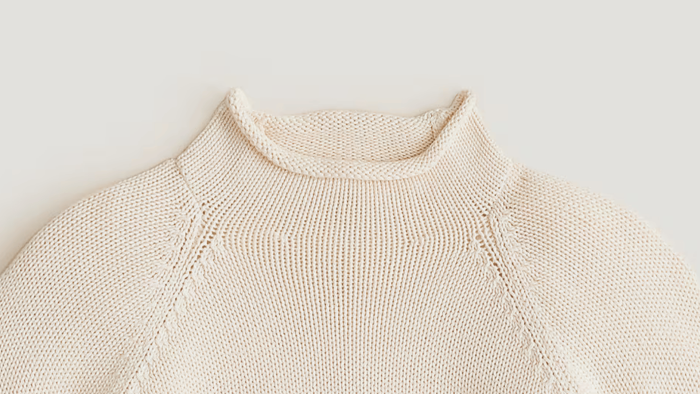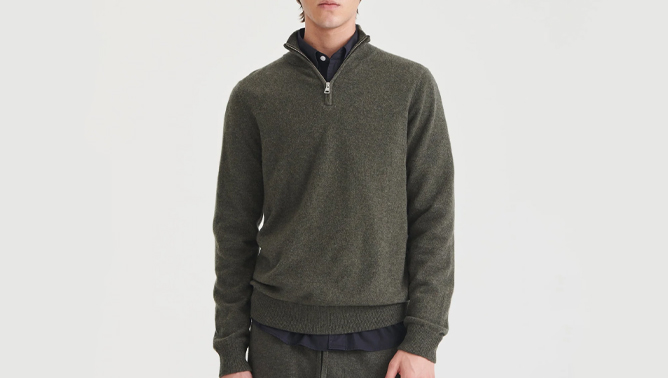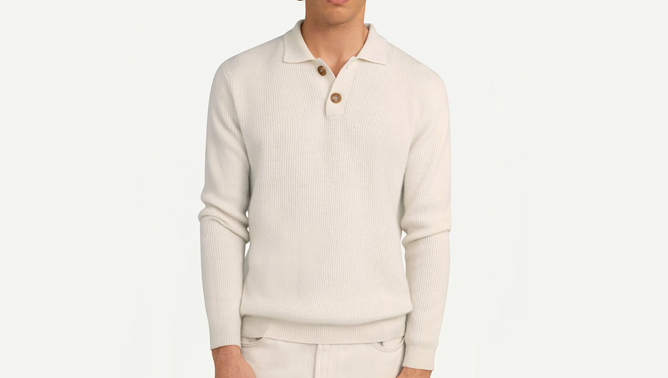From early fall and into the spring, you will find me in one fabric above all others: cashmere. Lightweight yet insulating, cashmere is the perfect balance of cozy while not being excessively bulky. While many guys may settle for an easy-going cotton sweater or throw on a traditional cableknit wool number, I’m here to tell you that cashmere is the way to go.
Unfortunately, cashmere has a reputation of being both expensive and fussy. I’ve heard every excuse in the book why guys haven’t added a couple cashmere pieces into their wardrobe: that it needs to be dry-cleaned (false), that it’s too pricey for everyday wear (false again), and that it’s only for rich people (absolutely not true). If you know where to look and how to care for it, cashmere can hold up for years and be a valuable and stylish asset in your wardrobe.
What is Cashmere?
Originating from the Kashmir region in South Asia, cashmere is a fiber obtained from the soft undercoat of cashmere goats. Since at least the 13th century, cashmere has been known as a luxury fabric, and this reputation still exists today. Part of that reputation comes from the geographical constraints of finding “authentic” cashmere, but also because it was so different at the time from the coarser fabrics of the day, like flax, linen, and rough cotton.
Since then, cashmere garments have become synonymous with well-crafted clothing that has always garnered a higher price tag. Cashmere is now produced across the world, including the UK, Australia, and China, and notion that cashmere has a leg-up on alternative cold-weather fabrics has never truly been lost.
In thinking about geographic variances in cashmere production, one can make an analogy that cashmere has a terroir similar to wine: each region will be slightly different. Mongolian cashmere continues to be the gold standard, while Scottish cashmere is finely produced and rugged. Chinese cashmere, while more affordable, may take a hit in quality, and Australian cashmere has come out in recent years as a great option for anyone looking for an alternative to Mongolia.
How to Wash Cashmere
Let’s go ahead and bust the myth that cashmere is dry-clean only. In fact, I’d highly advise against ever sending your sweaters off to the dry cleaner.
Instead, your bathtub or kitchen sink can do all the work and save you money. All you need is a gentle detergent (my go-to is Johnson’s baby shampoo) and some lukewarm water. Simply fill with lukewarm water and a squeeze of shampoo and lay your garment down. Swirl a few times and allow to sit for 20-30 minutes, mixing with your hands every few minutes. When done, drain and repeat with lukewarm water only and gently swirl the garment to remove any suds.
Next, lay out a towel on the floor and place your cashmere garment over top. Roll up the garment and press any excess water out. Repeat if you’d like, then lay totally flat on a drying rack or a table.
Cashmere doesn’t need to be washed as often as, say, a cotton garment, and all that washing can actually damage the garment over time. So once or twice a season is plenty for regular wear (unless, of course, it gets visibly dirty or begins to smell).
How to Style Cashmere
I find cashmere very simple to style in part due to the notion that it’s a luxury fabric. This, in turn, means I don’t have to over-style my outfit if I’m throwing on a cashmere sweater, as I already feel like I’m making an effort by simply putting it on. Sweaters are, by far, the best apparel to buy in cashmere, and I’d opt for a simple crewneck jumper to be able to wear during the weekend when out with friends or to put on over a nice Oxford shirt at work.
Alternatively, I have seen cashmere pop up in a variety of leisure options, especially since the pandemic. As I type this, I’m wearing a cashmere hoodie from Quince, while I’m debating on whether to go ahead and purchase a pair of cashmere joggers to complete the cozy ensemble.
Thicker garments, like cableknit sweaters and chunky cardigans, might be a blend of cashmere and wool, and that’s probably for the best. Due to how soft the fiber of pure cashmere can be, heavier garments tend to sag with longterm wear. Having a bit of wool helps to ensure structure over time.
When considering the delicacy of cashmere, I’d avoid investing in any cashmere socks or underwear. There’s no denying how comfortable they feel, but they do tend to rub and get holes fairly quickly compared to their cotton cousins.
Where to Buy Quality Cashmere
Billie Todd
Quality Scottish-milled cashmere takes center stage in Billie Todd's shirts, scarves, beanies, and sweaters.
BuyMore Features

The Rollneck Sweater Is a Style Icon, Here Are 5 To Buy Now
It's time to embrace the romantic, rugged rollneck sweater.

WhistlePig’s The Boss Hog XII: Feather & Flame Is a Deliciously Unconventional Rye Whiskey
Another winning release in the exclusive Boss Hog lineup.

The Cool Material 2025 Holiday Gift Guides
From style and home goods to EDC and food and drink, we rounded up the coolest gifts of the year.






